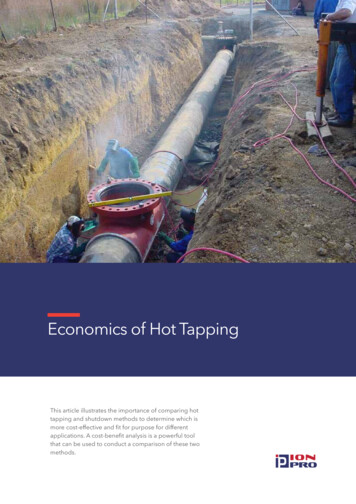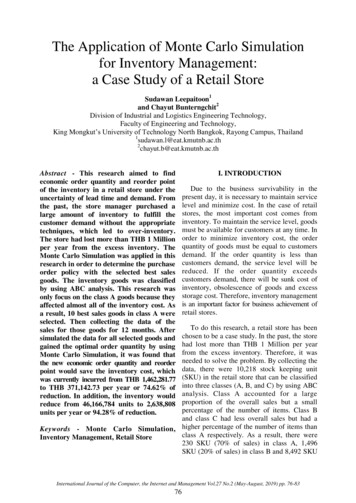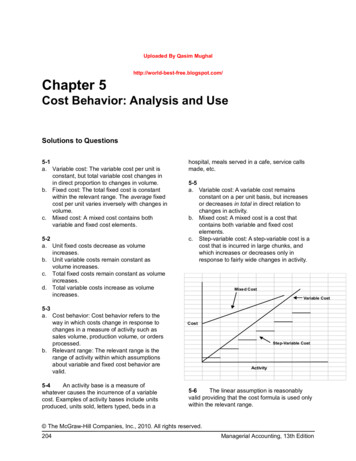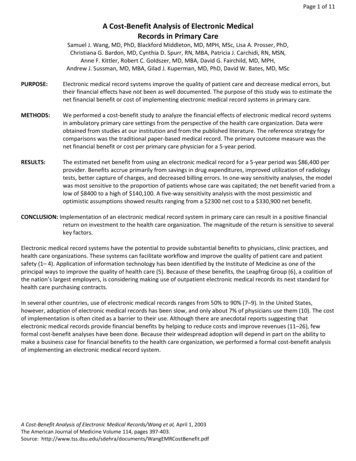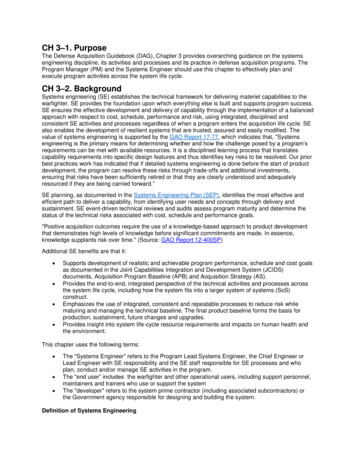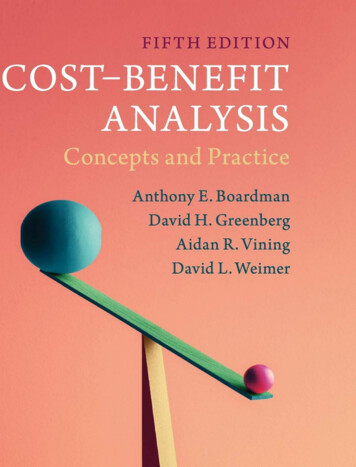
Transcription
Cost–Benefit AnalysisConcepts and PracticeFifth editionCost–Benefit Analysis provides accessible, comprehensive, authoritative, and practicaltreatments of the protocols for assessing the relative efficiency of public policies. Itsreview of essential concepts from microeconomics and its sophisticated treatment ofimportant topics with minimal use of mathematics helps students from a variety ofbackgrounds to build solid conceptual foundations. It provides thorough treatmentsof time discounting; dealing with contingent uncertainty using expected surpluses andoption prices; taking account of parameter uncertainties using Monte Carlo simulationand other types of sensitivity analyses; revealed preference approaches; statedpreference methods including contingent valuation; and other related methods.Updated to cover contemporary research, this edition is considerably reorganizedto aid in student and practitioner understanding, and includes eight new cases todemonstrate the actual practice of cost–benefit analysis. Widely cited, it is recognized asan authoritative source on cost–benefit analysis. Illustrations, exhibits, chapter exercises,and case studies help students to master concepts and develop craft skills.Anthony E. Boardman is a Professor Emeritus at the University of British Columbia.With colleagues, he has won the Peter Larkin Award, the Alan Blizzard Award, theJohn Vanderkamp prize, and the J.E. Hodgetts Award. He has also been a consultant tomany leading public-sector and private-sector organizations, including the Governmentof Canada and the Inter-American Development Bank. He served two terms on thePatented Medicine Prices Review Board and is currently on the Board of the Institutefor Health System Transformation and Sustainability.David H. Greenberg is Professor Emeritus of economics at the University of Maryland,Baltimore County (UMBC). He is a labor economist and cost–benefit analystwho received his PhD at MIT. Before coming to UMBC, he worked for the RandCorporation, SRI International, and the US Department of Health and HumanServices. He has taught courses in cost–benefit analysis at the University of WisconsinMadison, George Washington University, Budapest University of Economic Science,and Central European University. He is a long-time consultant to MDRC, AbtAssociates and other research organizations.Aidan R. Vining is the CNABS Professor of Business and Government Relationsat Simon Fraser University in Vancouver. With co-authors, he is a winner of theJohn Vanderkamp prize (Canadian Economics Association) and the J.E. HodgettsAward (Institute of Public Administration of Canada). With David Weimer, he is theco-author of Policy Analysis; Concepts and Practice.
David L. Weimer is the Edwin E. Witte Professor of Political Economy at the Universityof Wisconsin-Madison. He was president of the Association for Public Policy Analysisand Management in 2006 and president of the Society for Benefit–Cost Analysisin 2013. He is a past editor of the Journal of Policy Analysis and Management andcurrently serves on many editorial boards. He is also a Fellow of the National Academyof Public Administration.
Cost–BenefitAnalysisConcepts and PracticeFifth editionAnthony E. BoardmanUniversity of British Columbia, VancouverDavid H. GreenbergUniversity of Maryland, Baltimore CountyAidan R. ViningSimon Fraser University, British ColumbiaDavid L. WeimerUniversity of Wisconsin–Madison
University Printing House, Cambridge CB2 8BS, United KingdomOne Liberty Plaza, 20th Floor, New York, NY 10006, USA477 Williamstown Road, Port Melbourne, VIC 3207, Australia314–321, 3rd Floor, Plot 3, Splendor Forum, Jasola District Centre, New Delhi – 110025, India79 Anson Road, #06–04/06, Singapore 079906Cambridge University Press is part of the University of Cambridge.It furthers the University’s mission by disseminating knowledge in the pursuit ofeducation, learning, and research at the highest international levels of excellence.www.cambridge.orgInformation on this title: www.cambridge.org/9781108415996DOI: 10.1017/9781108235594First, second, third, fourth edition Pearson Education, Inc., 1996, 2001, 2006, 2011Fourth edition Anthony E. Boardman, David H. Greenberg, Aidan R. Vining, and David L.Weimer 2018Fifth edition Anthony E. Boardman, David H. Greenberg, Aidan R. Vining, and David L.Weimer 2018This publication is in copyright. Subject to statutory exceptionand to the provisions of relevant collective licensing agreements,no reproduction of any part may take place without the writtenpermission of Cambridge University Press.First edition 1996Second edition 2001Third edition 2006Fourth edition 2011 & 2018Fifth edition 2018Printed in the United States of America by Sheridan Books, Inc., 2018A catalogue record for this publication is available from the British LibraryLibrary of Congress Cataloging-in-Publication DataNames: Boardman, Anthony E., author.Title: Cost–benefit analysis : concepts and practice / Anthony E. Boardman,University of British Columbia, Vancouver, [and three others].Description: Fifth edition. Cambridge, United Kingdom ; New York, NY :Cambridge University Press, [2018]Identifiers: LCCN 2017056020 ISBN 9781108415996Subjects: LCSH: Cost effectiveness.Classification: LCC HD47.4 .C669 2018 DDC 658.15/54–dc23LC record available at https://lccn.loc.gov/2017056020ISBN 978-1-108-41599-6 HardbackISBN 978-1-108-40129-6 PaperbackAdditional resources for this publication at www.cambridge.org/Boardman5edCambridge University Press has no responsibility for the persistence or accuracyof URLs for external or third-party internet websites referred to in this publicationand does not guarantee that any content on such websites is, or will remain,accurate or appropriate.
ContentsPreface viiAcknowledgments viiiList of Cases ix1.Introduction to Cost–Benefit Analysis 12.Conceptual Foundations of Cost–Benefit Analysis3.Microeconomic Foundations of Cost–Benefit Analysis 55Appendix 3A. Consumer Surplus and Willingness to Pay 754.Valuing Impacts from Observed Behavior: Direct Estimation ofDemand Schedules 87Appendix 4A. Introduction to Multiple Regression Analysis 1025.Valuing Impacts in Output Markets6.Valuing Impacts in Input Markets7.Valuing Impacts in Secondary Markets8.Predicting and Monetizing Impacts 1829.Discounting Future Impacts and Handling Inflation 201Appendix 9A. Formulas for Calculating the Present Value of Annuities andPerpetuities 2262811914316210.The Social Discount Rate 23711.Dealing with Uncertainty: Expected Values, Sensitivity Analysis, and theValue of Information 269Appendix 11A. Monte Carlo Sensitivity Analysis using Commonly AvailableSoftware 29912.Risk, Option Price, and Option Value 315Appendix 12A. Signing Option Value 33213.Existence Value 339Appendix 13A. Expenditure Functions and the Partitioning of Benefits14.Valuing Impacts from Observed Behavior: Experiments and QuasiExperiments 35415.Valuing Impacts from Observed Behavior: Indirect Market Methods16.Contingent Valuation: Using Surveys to Elicit Information about Costsand Benefits 422389347
viContents17.Shadow Prices from Secondary Sources18.Cost–Effectiveness Analysis and Cost–Utility Analysis19.Distributionally Weighted CBA20.How Accurate Is CBA?Name Index 579Subject Index 586565537464511
PrefaceCollaborative academic projects often take longer than originally anticipated, not justbecause of the normal delays of coordinating the efforts of busy people, but also becauseinitially modest goals can become more ambitious as participants delve into their subject.We confess to both these sins with respect to preparing the first edition of this text. Ourgoal was to produce a book that would be conceptually sound, practically oriented, andeasily accessible to both students and practitioners. Although our final product was fardifferent in form and content than we initially planned, we believe that our first editionwas such a book.Our plans evolved for a number of reasons. Perhaps most importantly, throughour teaching of undergraduate and graduate students in different countries, as well asour experiences training government employees in different jurisdictions, we realizedthat many topics demanded extended treatment if the essential basics were to be conveyed effectively and if solid foundations were to be laid for further learning of advancedtopics. We also decided that integrating illustrations and examples with concepts andmethods is useful in addition to presenting independent cases. The result is a series ofchapters that develop conceptual foundations, methods of application, and extensionsof cost–benefit analysis (CBA) through numerous practical examples and illustrations.Our own use of the book in teaching, as well as comments from other teachersand students, have helped us identify several areas for incremental improvement in subsequent editions. With this current edition, however, we decided to take a fresh look at bothorganization and content. With respect to organization, we interlace the chapters providing the theoretical foundations with those showing how to implement them. For e xample,the chapter introducing the basics of measuring social surplus changes in markets isfollowed immediately with the chapter on estimating demand schedules. With respectto content, we added a number of cases that show the application of concepts in policyanalyses. For example, following the chapter on estimating demand schedules, we providecases presenting the use, and misuse, of social surplus as a benefit measure in regulatoryimpact analyses. Other cases illustrate using evidence from multiple sources to arrive atnet benefits, conducting Monte Carlo simulation to assess uncertainty in net benefits,estimating costs and benefits from social experiments, using contingent valuation methods to assess the benefits of non-market goods, developing a shadow price from multipledata sources, and weighting costs and benefits to incorporate distributional values.In overview, this new fifth edition provides the following: Updated content and references Rearrangement of chapters to facilitate better integration of theory and craft Addition of six cases providing extended illustrations of CBA craftAs with the earlier editions, answers to chapter problems, including spreadsheetsthat can be provided to students, are available for instructors.
AcknowledgmentsOur project over the years has been made more productive and enjoyable by our manycolleagues and students who gave us advice, comments, encouragement, or information.We thank here just a few people who were particularly helpful: Marcus Berliant, EdwardBird, James Brander, Stanley Engerman, Eric Hanushek, Robert Havemen, DougLandin, Walter Oi, William G. Waters II, and Michael Wolkoff. We thank Roy I. Gobin,George T. Fuller, Ruth Shen, and Larry Karp, who wrote thoughtful reviews of the firstedition for the publisher; Ian Davis, John DeWald, Tim Gindling, and Laurie T. Johnson,who offered valuable comments during preparation of the second edition; Terri Sextonand Nachum Sicherman, who offered valuable comments during preparation of the thirdedition; Thomas Hopkins and M. Leslie Shiell, who offered valuable comments during preparation of the fourth edition; and John Janmaat, Farhad Sabetan, and GideonYaniv, who offered valuable comments during preparation of the fifth edition. HaynesGoddard kindly provided helpful suggestions for both the second and third editions. Weespecially thank Mark Moore, whose joint work with us helped us substantially improveour discussion of the social discount rate, and Roger Noll, who made extremely valuable suggestions that prompted many other substantial revisions. Of course, they are notresponsible for any errors that remain.We also thank Robert Dreesen and the editorial team at Cambridge UniversityPress for encouraging us to take the time to do a substantial revision. We hope that teachers and students find the new edition to be both authoritative and pedagogically effective.
List of CasesCase 4Use of Demand Schedules in Regulatory Impact Analyses 110Case 8WSIPP CBA of the Nurse–Family Partnership Program 196Case 9A CBA of the North-East Mine Development Project 233Using Monte Carlo Simulation: Assessing the Net Benefits of EarlyDetection of Alzheimer’s Disease 308Case 14Findings from CBAs of Welfare-to-Work Programs 383Case 16Using Contingent Valuation to Estimate Benefits from Higher Education 460Case 17Shadow Pricing a High School Diploma 504Case 19The Tulsa IDA Account Program 558Case 11
1Introduction to Cost–Benefit AnalysisIn the Affair of so much Importance to you, wherein you ask my Advice, Icannot for want of sufficient Premises, advise you what to determine, but ifyou please I will tell you how. When those difficult Cases occur, they are difficult, chiefly because while we have them under Consideration, all the Reasonspro and con are not present to the Mind at the same time; but sometimesone Set present themselves, and at other times another, the first being out ofSight. Hence the various Purposes or Inclinations that alternately prevail,and the Uncertainty that perplexes us.To get over this, my Way is, to divide half a Sheet of Paper by a Line intotwo Columns; writing over the one Pro, and over the other Con. Thenduring three or four Days Consideration, I put down under the differentHeads short Hints of the different Motives, that at different Times occurto me, for or against the Measure. When I have thus got them all togetherin one View, I endeavor to estimate their respective Weights; and where Ifind two, one on each side, that seem equal, I strike them both out. If Ifind a Reason pro equal to some two Reasons con, I strike out the three. IfI judge some two Reasons con, equal to some three Reasons pro, I strikeout the five; and thus proceeding I find at length where the Balance lies;and if after a Day or two of farther consideration, nothing new that is ofImportance occurs on either side, I come to a Determination accordingly.And, tho’ the Weight of Reasons cannot be taken with the Precision ofAlgebraic Quantities, yet, when each is thus considered, separately andcomparatively, and the whole lies before me, I think I can judge better,and am less liable to make a rash Step; and in fact I have found greatAdvantage from this kind of Equation, in what may be called Moral orPrudential Algebra.B. Franklin, London, September 19, 177211.1Individual Versus Social Costs and BenefitsBenjamin Franklin’s advice about how to make decisions illustrates many of the important features of cost–benefit analysis (CBA). These include a systematic cataloguingof impacts as benefits (pros) and costs (cons), valuing the impacts in dollars (assigningweights), and then determining the net benefit of the proposal relative to the current policy (net benefit equal incremental benefits minus incremental costs).
2Introduction to Cost–Benefit AnalysisWhen we as individuals talk of costs and benefits, we naturally tend toconsider our own costs and benefits, generally choosing among alternative coursesof action according to whichever has the largest net benefit from our perspective.Similarly, in evaluating various investment alternatives, a firm tends to consider onlythose costs (expenditures) and benefits (revenues) that accrue to it. In CBA we try toconsider all of the costs and benefits to society as a whole, that is, the social costs andthe social benefits. For this reason, some analysts refer to CBA as social cost–benefitanalysis.CBA is a policy assessment method that quantifies in monetary terms the value ofall consequences of a policy to all members of society. Throughout this book we use theterms policy and project interchangeably. More generally, CBA applies to policies, programs, projects, regulations, demonstrations, and other government interventions. Thebroad purpose of CBA is to help social decision-making and to increase social value or, moretechnically, to improve allocative efficiency.CBA analysts focus on social costs and social benefits, and conduct social cost–benefit analysis. However, it is tedious to keep including the word “social”. We usuallydrop it and simply refer to costs, benefits, and cost–benefit analysis. Thus, B denotesthe social benefits (the aggregate benefits to all members of society) of a policy, and Cdenotes the social costs (the aggregate costs to all members of society) of the policy. Theaggregate value of a policy is measured by its net social benefit, sometimes simply referredto as the net benefit, and usually denoted NSB:NSB B C(1.1)The term social is usually retained in the expression net social benefit to emphasize thatCBA does concern the impacts on society as a whole.Implicitly, the benefits, costs, and net social benefit of a policy are relative tosome “benchmark.” Usually, the “benchmark” is the status quo policy, that is, no changein the current policy. Generally, the benefits, costs, and net social benefit of a policymeasure incremental changes relative to the status quo policy.Stated at this level of abstraction, it is unlikely that many people would disagreewith doing CBA from an ethical perspective. In practice, however, there are two types ofdisagreements. First, social critics, including some political economists, philosophers, libertarians, and socialists, have disputed the fundamental utilitarian assumptions of CBAthat the sum of individual utilities should be maximized and that it is possible to tradeoff utility gains for some people against utility losses for others. These critics are notprepared to make trade-offs between one person’s benefits and another person’s costs.Second, participants in the public policy-making process (analysts, bureaucrats, and politicians) may disagree about such practical issues as what impacts will actually occur overtime, how to monetize (attach value to them), and how to make trade-offs between thepresent and the future.In this chapter we provide a non-technical but reasonably comprehensive overview of CBA. Although we introduce a number of key concepts, we do so informally,returning to discuss them thoroughly in subsequent chapters. Therefore, this chapter isbest read without great concern about definitions and technical details.
31.2Types of CBA AnalysesTypes of CBA AnalysesCBA may be conducted at different times in the project or policy life cycle. One type ofCBA is called ex ante or prospective CBA. Ex ante literally means “before.” Thus, ex anteCBA is conducted before the decision is made to undertake or implement a project orpolicy. The policy may or may not be under consideration by a government agency. If itis, then ex ante CBA informs the decision about whether resources should be allocatedto that specific project or policy or not. Basically, ex ante CBA attempts to answer thequestion: would this policy or project be a good idea, that is, would it have a positive netsocial benefit?Another type of CBA is called ex post or retrospective CBA. Ex post literallymeans “after.” Thus, strictly speaking, ex post CBA is conducted after a policy or projectis completed. It addresses the question: was this policy or project a good idea? Becauseex post analysis is conducted at the end of the project, it is obviously too late to reverseresource allocation decisions with respect to that particular project. However, this type ofanalysis provides information not only about a specific intervention, but also about the“class” of similar interventions. In other words, it contributes to learning by governmentmanagers, politicians, and academics about the costs and benefits of future projects andwhether they are likely to be worthwhile. Such learning can be incorporated into futureex ante CBAs. The potential benefit, however, depends on the similarity between thefuture project and the project previously analyzed. For example, ex post CBAs of experiments involving the efficacy of new surgical procedures or new pharmaceutical productscan usually be generalized to larger populations. However, if the proposed interventionis much bigger than the experiment, there may be unknown scale effects. Also, if theproposed program has a more extended time frame than the experiment, behavioralresponses may affect costs or benefits unpredictably.Most projects take many years to “complete.” The impacts of a highway or subway system, for example, often continue for many decades (even centuries) after initialconstruction. In such cases, and, in fact, for any ongoing policy or project, prudent government analysts might well wish to conduct a CBA sometime after the policy or projecthas begun but before it is complete. To clarify that such an analysis applies to a stillongoing project, such studies are sometimes called in medias res CBAs (to maintain ourfancy use of Latin). They attempt to answer the question: is continuation of this policyor project a good idea? An in medias res CBA can be conducted any time after the decision to undertake a project has been made (but before it is complete). Such studies arealso called post-decision analyses.An in medias res CBA might recommend the termination or modification ofa particular policy or project. In practice, CBAs of infrastructure projects with largesunk costs are unlikely to recommend discontinuation of a project that is near to completion or even just after completion, but it does happen occasionally. Interestingly theTennessee Valley Authority decided to complete the Tellico Dam when it was 90 percentcomplete, even though the incremental social costs exceeded the incremental social benefits.2 Also, a Canadian Environmental Assessment panel recommended decommissioning
4Introduction to Cost–Benefit Analysisa just-completed dam on the basis of an in medias res analysis which showed that, withuse, future environmental costs would exceed future benefits.3Many businesses and critics of government complain about the burden of existing regulations and of too much “red tape.” In medias res CBAs of some regulationsmight find that the critics are correct and they should be scrapped or changed for thebenefit of society as a whole. In fact, in medias res CBAs conducted during the 1960sand 1970s of industry-specific economic regulations showed that the costs of regulationoften exceeded the benefits, thereby paving the way for deregulation initiatives in thetrucking, airline, and telecommunications industries.4 These decisions were made botheconomically and politically easier by the reality that, unlike many physical infrastructure projects, regulatory projects usually have significant ongoing costs, rather than sunk,up-front costs. The same point also applies to ongoing social programs, such as government-funded training programs.In practice, the term in medias res CBA is not used often: such CBAs are referredto as ex post, retrospective, hindsight, or post-decision analyses. It is particularly important if this is the case, therefore, to be clear when an ex post CBA is conducted: it mightbe any time after the decision to implement a new policy has been made.There is also a fourth type of CBA – one that compares an ex ante CBA withan ex post CBA or an in medias res CBA of the same project.5 Considerable research hasfound, for example, that the costs of large government infrastructure projects are oftenunderestimated.6 In contrast, another study that assessed the accuracy of US regulatorycost estimates found that these costs tend to be overestimated.7 This comparative type ofCBA helps to identify past errors, understand the reasons for them, and avoid them inthe future.1.3The Basic Steps of CBA: Coquihalla Highway ExampleCBA may look quite intimidating and complex. To make the process of conducting aCBA more manageable, we break it down into 10 basic steps, which are listed in Table1.1. We describe and illustrate these steps using a relatively straightforward example: theproposed construction of a new highway. For each step, we also point out some practical difficulties. The conceptual and practical issues that we broach are the focus of therest of this book. Do not worry if the concepts are unfamiliar to you; this is a dry run.Subsequent chapters fully explain them.Suppose that in 1986 a cost–benefit analyst, who worked for the Province ofBritish Columbia, Canada, was asked to perform an ex ante CBA of a proposed fourlane highway between the town of Hope in the south-central part of the province andMerritt, which is north of Hope. This highway would pass through an area called theCoquihalla (an indigenous name) and would be called the Coquihalla Highway. A summary of the analyst’s ex ante CBA is presented in Table 1.2. The original numbers werepresent values as of 1986, which have now been converted to 2016 dollars to make them
5The Basic Steps of CBATable 1.1 The Major Steps in CBA1. Explain the purpose of the CBA2. Specify the set of alternative projects3. Decide whose benefits and costs count (specify standing)4. Identify the impact categories, catalogue them, and select metrics5. Predict the impacts quantitatively over the life of the project6. Monetize (attach dollar values to) all impacts7. Discount benefits and costs to obtain present values8. Compute the net present value of each alternative9. Perform sensitivity analysis10. Make a recommendationTable 1.2 Coquihalla Highway CBA (2016 Million)No tollsWith tollsGlobalProvincialGlobalProvincialperspective (A) perspective (B) perspective (C) perspective (D)Social benefits:Time and operating cost savings 763.0Safety benefits70.5New users1.6Alternate route benefits28.6Toll revenues–Terminal value of ��104.3426.337.00.413.973.2104.3Total social benefits968.0751.7741.0655.1Total social 14.916.40.6693.7661.814.916.40.6693.7Net social benefit291.275.247.3–38.6Social costs:ConstructionMaintenanceToll collectionToll booth constructionSource: Adapted from Anthony Boardman, Aidan Vining, and W. G. Waters II, “Costs and Benefitsthrough Bureaucratic Lenses: Example of a Highway Project,” Journal of Policy Analysis andManagement, 12(3), 1993, 532–55, table 1, p. 537.
6Introduction to Cost–Benefit Analysiseasier to interpret. How did the analyst obtain these numbers? What were the difficulties?We go through each of the 10 steps in turn.1.3.1Explain the Purpose of the CBAStep 1 requires the analyst to explain why she is conducting a CBA. She should answerthe question: what is the rationale for considering a change in policy, in this case, buildinga new highway? Stated broadly, the goal of CBA is to improve social welfare. More specifically, CBA attempts to maximize allocative efficiency, which we discuss in Chapter 3.That chapter argues that, where markets work well, individual self-interest leads to anefficient allocation of resources and, therefore, there should be no government intervention. Prima facie rationales for CBAs are market failure or government failure.8 Wherethere is market failure, analysts use CBA to assess whether a particular intervention ismore allocatively efficient than no intervention (or some other alternatives). Sometimesthere is government failure: a government policy or project is currently in effect, but thispolicy appears to be less allocatively efficient than no intervention or some other alternative policy. In either of these situations CBA attempts to ascertain whether a new policy or program is more allocatively efficient than the existing policy. The analyst shouldexplain the market failure or government failure that provides a purpose for the study.In 1986, the existing routes to the interior of northern British Columbia werehighly congested, dangerous (with many traffic accidents), and would not have the capacity to handle anticipated increases in traffic volumes. For political reasons, the government was unwilling to impose tolls on the existing routes. Widening the main road wouldhave been prohibitively expensive because much of it was in a river canyon. The focus ofthe study was, therefore, on whether to build a new highway between Hope and Merritt inan alternative location, specifically in the Coquihalla Valley, which follows the ColdwaterRiver.1.3.2Specify the Set of Alternative ProjectsStep 2 requires the analyst to specify the set of alternative projects. In this example, therewere only two feasible alternative highway projects: one built with tolls and one without.The provincial department of transportation decided that the toll, if applied, would be 78.3 for large trucks and 15.7 for cars (in 2016 dollars). Thus, the analyst had a tractable set of only two alternatives to analyze.In practice, there are often difficulties even at this stage because the number ofpotential alternatives is often quite large. Even restricting the analysis to a highway inthe Coquihalla valley, it could vary on many dimensions including, for example, the roadsurface (either bitumen or concrete), routing (it could take somewhat different routes),size (it could have more or fewer lanes), toll level (could be higher or lower), wild animalfriendliness (the highway could be built with or without “elk tunnels”), or timing (itcould be delayed until a later date). Resource and cognitive constraints mean that analysts typically analyze only a few alternatives.9CBA compares one or more potential projects with a project that would bedisplaced (i.e., not undertaken) if the project(s) under evaluation were to proceed. The
7The Basic Steps of CBAdisplaced project is often called the counterfactual. Usually, the counterfactual is the status quo policy or no change in government policy. It does not mean “do nothing.” Itmeans that government continues to do what it has been doing: while there would be nonew highway, the existing highway would continue to be maintained. Table 1.2 presentsthe social benefits, social costs
Baltimore County (UMBC). He is a labor economist and cost–benefit analyst who received his PhD at MIT. Before coming to UMBC, he worked for the Rand Corporation, SRI International, and the US Department of Health and Human Services. He has taught courses


